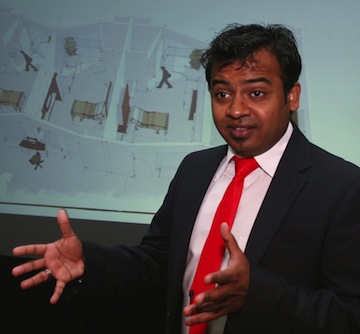Houston-based WHR Architects has named Lia Rodi, AIA, LEED AP, as the new curator of the firm’s Tradewell Fellowship Program, now in its 15th year. A past Tradewell Fellow, Rodi’s first official duty was the announcement of the 2012 Fellow Akshay Sangolli.
“It’s an honor to assume responsibility for the Tradewell program,” said Rodi. “Fourteen years ago, my own year as a Tradewell Fellow under the guidance of Kirk Hamilton was the ideal preparation for my new role. My experience and work with other Tradewells over the years has provided a model that will help to be of the best possible service to the Fellowship as a leader and mentor.”
Although internships are a tradition in the architectural profession, there are still few fellowships that offer recent graduates a focused opportunity to gain experience working closely with senior firm leaders and significant interaction with clients. This year’s Fellow, Akshay Sangolli, pursued the Tradewell in recognition of its exceptional nature. “It is a unique opportunity that puts you at an entirely different level at the outset of your career,” said Sangolli. “The Tradewell Fellowship offers [a] perfect combination of professional guidance, academic realization, and hands-on learning.”
The year-long Tradewell Fellowship was established by David Watkins, FAIA, president and chairman of WHR Architects, along with Kirk Hamilton, FAIA, FACHA, EDAC, now a professor at Texas A&M University and associate director for the Center for Health Systems and Design, in honor of the late Gary Tradewell, a former vice president and medical planner at WHR. The fellowship focuses on building careers of aspiring healthcare architects. Each year the Tradewell Fellow is involved with clients in early master planning and design, with a particular focus on healing environments and collaborative design methods as part of their employment at WHR. In addition to working directly with senior medical planners on design projects, Fellows receive career guidance from leaders at WHR and a network of past Tradewell Fellows.
In addition to project assignments, the Fellow also receives a scholarship to attend a healthcare architecture conference, and the opportunity to attend in-house educational presentations. Other educational opportunities include: assisting with teaching a graduate-level course on health facility planning, design, and construction; participating in evidence-based design activities; and assisting members of the firm in authoring speeches, articles, or books.
Fellows are selected by the group of past Tradewells at WHR, based on the strength of their design portfolios, letters of recommendation, and essays describing their accomplishments and career goals.
Sangolli, who began his fellowship in June, summarized his goals: “In the long term, I want explore how architecture can enhance human health, healing and well-being. I hope to participate in improving the quality of the built environment and its implications on human life around the world, especially in much-neglected developing nations.”
Related Stories
| Nov 15, 2010
Gilbane to acquire W.G. Mills, Inc.
Rhode Island-based Gilbane Building Company announced plans to acquire W.G. Mills, Inc., a construction management firm with operations based in Florida. The acquisition will dramatically strengthen Gilbane’s position in Florida’s growing market and complement its already established presence in the southeast.
| Nov 11, 2010
Saint-Gobain to make $80 million investment in SAGE Electrochromics
Saint-Gobain, one of the world’s largest glass and construction material manufacturers, is making a strategic equity investment in SAGE Electrochromics to make electronically tintable “dynamic glass” an affordable, mass-market product, ushering in a new era of energy-saving buildings.
| Nov 11, 2010
Saint-Gobain to make $80 million investment in SAGE Electrochromics
Saint-Gobain, one of the world’s largest glass and construction material manufacturers, is making a strategic equity investment in SAGE Electrochromics to make electronically tintable “dynamic glass” an affordable, mass-market product, ushering in a new era of energy-saving buildings.
| Nov 11, 2010
USGBC certifies more than 1 billion square feet of commercial space
This month, the total footprint of commercial projects certified under the U.S. Green Building Council’s LEED Green Building Rating System surpassed one billion square feet. Another six billion square feet of projects are registered and currently working toward LEED certification around the world. Since 2000, more than 36,000 commercial projects and 38,000 single-family homes have participated in LEED.
| Nov 10, 2010
$700 million plan to restore the National Mall
The National Mall—known as America’s front yard—is being targeted for a massive rehab and restoration that could cost as much as $700 million (it’s estimated that the Mall has $400 million in deferred maintenance alone). A few of the proposed projects: refurbishing the Grant Memorial, replacing the Capitol Reflecting Pool with a smaller pool or fountain, reconstructing the Constitution Gardens lake and constructing a multipurpose visitor center, and replacing the Sylvan Theater near the Washington Monument with a new multipurpose facility.
| Nov 9, 2010
Just how green is that college campus?
The College Sustainability Report Card 2011 evaluated colleges and universities in the U.S. and Canada with the 300 largest endowments—plus 22 others that asked to be included in the GreenReportCard.org study—on nine categories, including climate change, energy use, green building, and investment priorities. More than half (56%) earned a B or better, but 6% got a D. Can you guess which is the greenest of these: UC San Diego, Dickinson College, University of Calgary, and Dartmouth? Hint: The Red Devil has turned green.
| Nov 9, 2010
12 incredible objects being made with 3D printers today
BD+C has reported on how 3D printers are attracting the attention of AEC firms. Now you can see how other creative types are utilizing this fascinating printing technology. Among the printed items: King Tut’s remains, designer shoes, and the world’s smallest Rubik’s Cube.
| Nov 9, 2010
U.S. Army steps up requirements for greening building
Cool roofs, solar water heating, and advanced metering are among energy-efficiency elements that will have to be used in new permanent Army buildings in the U.S. and abroad starting in FY 2013. Designs for new construction and major renovations will incorporate sustainable design and development principles contained in ASHRAE 189.1.









